The Evolution of Bath Trends: A Comprehensive Exploration
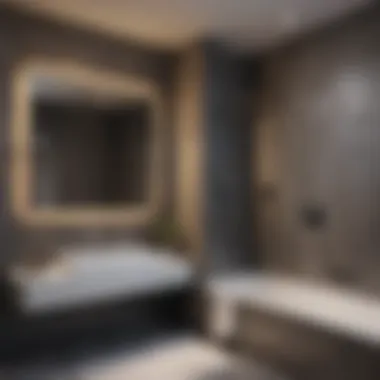
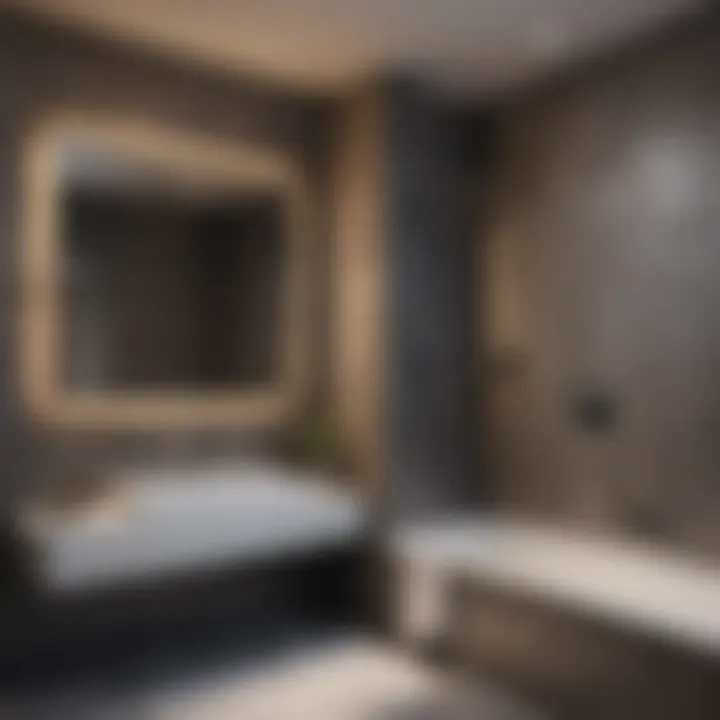
Intro
The world of bath trends is ever-changing, painting a vivid picture that encapsulates more than just the physical place of bathing. It serves as a canvas, reflecting the desires, needs, and philosophies of each era. Today, as homeowners strive to carve out personal sanctuaries within their homes, the bathroom has evolved from a mere utility space into a wellness oasis. Shifting trends showcased in design, innovative products, and an increasing focus on mindfulness are reshaping our baths into serene spaces. This article distills these changes, providing guidance on how to transform your bathroom into a realm of relaxation and aesthetic pleasure, blending functionality with style.
Design Inspirations
Trending Styles
When it comes to bath design, trends change faster than a playlist at a DJ's set. The contemporary bathroom often draws inspiration from nature. Biophilic design, with the infusion of organic shapes and materials, plays a central role in current layouts. Imagine smooth lines, the rustic charm of reclaimed wood, and the serenity of stone finishes, all harmoniously merging together. Key styles emerging are the minimalist aesthetic, which emphasizes the simplicity of form and function, and the retro revival, which introduces bold patterns and colors reminiscent of the mid-20th century.
Color Palettes
Color choices in the bathroom have also seen a seismic shift. Gone are the days of bland, all-white rooms. Today, palettes lean towards rich, earthy hues that evoke a sense of tranquility. Consider deep greens and soft blues, reminiscent of calm waters or a forest’s embrace. Accents of copper or brass can add warmth and character, breaking up the monotony while still providing a soothing ambiance. Moreover, the trend towards monochromatic schemes, using different shades of the same color, creates a visually appealing space that feels cohesive and inviting.
"Design is not just what it looks like and feels like. Design is how it works." – Steve Jobs
Product Recommendations
Bath Accessories
Innovative products play a critical role in elevating the bathing experience. Consider shower heads that provide a spa-like experience with adjustable settings for pressure and light. Brands like Moen and Delta stand out for their ergonomic designs. Then there are the sleek, space-saving bathtubs, like those made by Kohler, that seamlessly blend into modern aesthetics while maximizing comfort. Accessories matter too. From plush towels, which can transform the feeling of luxury, to diffusers that fill the air with calming scents, every detail contributes to a holistic bathing experience.
Bedroom Essentials
As the boundaries between bathroom and bedroom blur, certain essentials in the latter can enhance your bathing environment. A cozy bathrobe, kept close at hand, invites warmth post-soak. Quality slippers greatly add to the overall feel and nourish those first moments of stepping out of the relaxation-filled bath. Storage solutions, such as stylish baskets or vintage cabinets, add character while ensuring your essentials are organized and at hand.
In summary, navigating through the evolution of bath trends is akin to journeying through a gallery of modern living. From the materials and colors embraced to the carefully curated products that complete the experience, each element plays a role in crafting a serene sanctuary for homeowners. Embracing these trends not only enhances the aesthetic appeal but also channels a deeper connection to personal wellness.
The Changing Face of Bath Design
The bath design has transitioned significantly over the years, becoming an essential aspect of home aesthetics and personal well-being. The importance of this topic cannot be overstated, as the bathroom is not just a functional space; it’s increasingly perceived as a personal sanctuary where one can unwind and rejuvenate. This evolution reflects broader trends in society where the emphasis is on self-care and creating comfortable living environments.
There are various elements that underscore the changing dynamics of bath design:
- Inclusivity of Personalization: Homeowners are now looking to tailor their baths to reflect their unique preferences. Whether it’s choosing fixtures that match a specific theme or selecting colors that evoke a sense of calm, personal choices shape today’s bath spaces.
- Functional Design: The modern bathroom must strike a balance between aesthetics and functionality. Features like integrated storage solutions and multi-functional fixtures are becoming staples, making spaces both pleasing to the eye and practical for everyday use.
- Wellness Integration: Bath spaces now reflect growing wellness trends. Elements like spa-like features—think of soaking tubs, rainfall showers, and aromatherapy options—invite relaxation and promote self-care.
Overall, this section of the article sheds light on how these aspects intertwine to create bathing spaces that are not just practical, but also serve as personal retreats, enhancing quality of life in homes.
Historical Context of Bathing Spaces
Bathing has been a significant part of human culture for centuries, with its roots tracing back to ancient civilizations. Originally, bathing was often communal and ritualistic. The Romans, for instance, built complex public baths that served as social hubs where people would gather to clean themselves and socialize. These baths were not merely about hygiene; they symbolized wealth and sophistication. Over time, personal bathing spaces began to evolve, reflecting societal views on privacy, comfort, and luxury.
In the Victorian era, the concept of the bathroom as a private space emerged, leading to an increased interest in sanitary installations. The introduction of indoor plumbing revolutionized personal hygiene. Fast forward to the 20th century, and bathrooms began to be adorned with decorative tiles, updated fixtures, and vanity areas, which highlighted the trend of creating distinctive personal spaces aligned to individual tastes.
Modern Influences on Bath Aesthetics
Today, bath design is shaped by numerous trends influenced by technology, environmental considerations, and shifting consumer preferences. One of the main currents in modern bath aesthetics is minimalism. This stylistic approach emphasizes clean lines and decluttered spaces, making rooms feel open and serene.
Sustainable materials are playing a crucial role as well. Brands are innovating with eco-friendly options that don’t compromise on style or durability. For instance, recycled glass tiles or bamboo vanities offer a blend of modern design and environmental consciousness.
Additionally, the rise of smart technology continues to influence how spaces are designed and experienced. From smart showers that adjust temperature to the perfect setting with a simple voice command to mirrors that can share news or streaming services, tech-savvy features are making their way into modern baths, changing how we perceive the space altogether.
"A bathroom is no longer just a functional space; it's a blend of comfort, technology, and design that defines a personal retreat."
In summary, as bath design continues to evolve, it integrates historical influences with modern expectations, reflecting societal changes and personal lifestyles.
Key Elements of Contemporary Bathroom Design
The design of a bathroom serves as more than just a functional space; it reflects personal style and lifestyle choices, impacting one's daily routine and mental well-being. This section delves into key elements that have become integral to contemporary bathroom design, highlighting what homeowners ought to consider when revamping or creating their bathing haven. These elements work together to create a harmonious blend of functionality, aesthetic appeal, and a hint of indulgence, ensuring a space that meets both practical needs and personal delight.
Material Choices: Looking Beyond Tiles
Historically, tiles have dominated the bathroom flooring and wall surfaces. However, recent trends suggest a shift towards diverse material choices that add depth and character. Homeowners are discovering the benefits of incorporating materials such as natural stone, polished concrete, and even wood, despite its moisture sensitivity. Each offers a unique texture and visual aspect that tiles simply can't replicate.

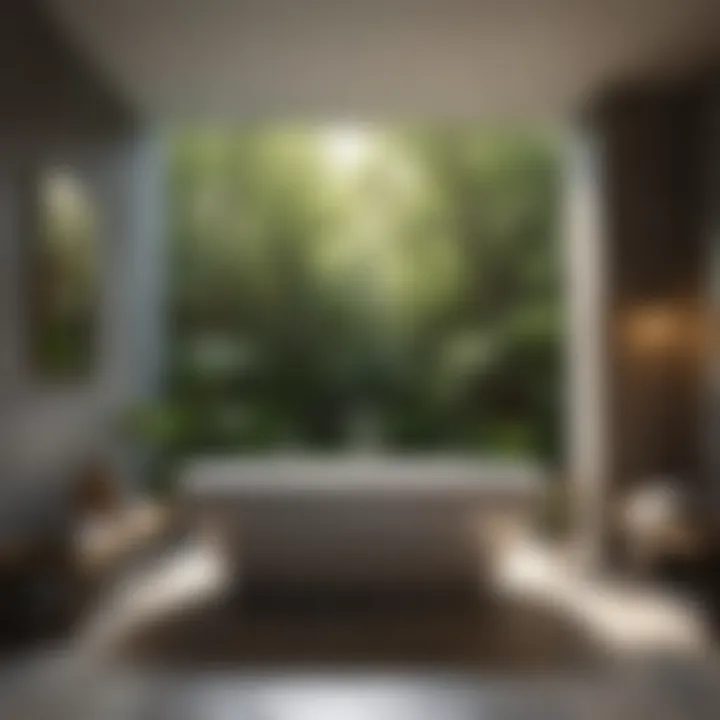
Natural stone, like slate or marble, brings a luxurious vibe. Polished concrete lays a more industrial yet sleek foundation. Wood can introduce warmth, especially when treated for water resistance. It’s prudent to weigh the pros and cons – while stones are durable, they can be costly, and wood demands careful maintenance. Mixing and matching these materials can expand design possibilities, transforming a bath into a mini retreat.
"The key is to enhance the emotional experience within the space, not just its utility."
Color Palettes: Trends Shaping Ambiance
In terms of color, contemporary bathrooms are stepping away from an all-white palette, slowly embracing bolder, mood-boosting shades. Soft pastels have been all the rage, yet deeper tones like navy and forest green are creating unique atmospheres that reflect personality and style. The choice of color can drastically alter the perception of space and ambiance.
In addition to solid colors, homeowners are now experimenting with patterns that can evoke a sense of flair. Wallpaper, once shunned due to humidity, has seen a comeback with moisture-resistant varieties. Consideration should also be given to how light interacts with colors—dark hues absorb light, making spaces feel smaller, while lighter shades tend to open up environments.
Creating a color transition between the bath and adjoining areas contributes to a cohesive feel throughout the home. Using similar hues and tones guides the eye and sets a calming tone.
Lighting Innovations in Bath Spaces
From simple overhead fixtures to elaborate mood lighting, innovations in lighting are redefining the bathing experience. Technology has advanced so that lighting is not merely functional, but an essential part of how one engages with the space.
- LED lighting remains a top choice for its energy efficiency and versatility. These lights can be placed under cabinets or around mirrors to enhance visibility while creating a soothing atmosphere.
- Dimmer switches have also gained traction, allowing homeowners to adjust brightness levels, suitable for everything from a lively morning routine to a calming evening soak.
- Additionally, smart lighting systems can be integrated, enabling control via apps or voice commands, bringing a new level of convenience.
This trend emphasizes how light influences mood and perception. Whether making a space feel airy or intimate, thoughtful lighting is key in contemporary bathrooms.
In wrapping up this section, it's clear that paying attention to the key elements of contemporary bathroom design isn’t just about choosing what looks good; it's about creating a multifunctional sanctuary that speaks to one's tastes and needs.
Sanctuary and Wellness: The Bath as a Personal Retreat
In recent years, the bathroom has transformed into more than just a utility space - it's become a sanctuary for relaxation and wellness. Homeowners today are recognizing that the act of bathing offers substantial benefits not just physically, but emotionally as well. The modern bath is no longer seen merely as a practical necessity but as a personal retreat that cultivates tranquility and self-care.
The concept of sanctuary in the bathing area emphasizes the importance of creating a space that is not only visually appealing but also conducive to relaxation. A designated space for rest and rejuvenation allows individuals to escape the daily hustle and bustle. When one sinks into a warm bath, the world outside seems to fade, providing a moment of solitude that is often hard to come by in our fast-paced lives.
The benefits of creating a wellness-focused environment in the bathroom are numerous. For one, a thoughtfully arranged bathroom can promote better mental health. Guests declaring they feel rejuvenated after a soak in a well-designed tub isn't just small talk; it's based on psychological principles that suggest environments can influence our mood and overall well-being.
Also, considering factors such as color, texture, and scent can significantly impact the atmosphere of a bathroom. Soft hues and natural materials can contribute to a serene environment, while aromatic oils or calming candles can further enhance the sensory experience. These elements work together to make the bathing experience not only a routine activity but also a restorative ritual.
"The bathroom is where you re-group, get ready for the day, or wind down in the evening. It's your personal stage for self-care."
The Role of Bathtubs in Modern Relaxation
Bathtubs play a pivotal role in crafting this retreat-like experience. The selection of a bathtub can dictate the overall feel of the room. Freestanding tubs often serve as statement pieces that center the design while inviting users to indulge in relaxation. The size and shape, whether it be a deep soaking tub or a contemporary Japanese-inspired tub, can greatly affect how one uses the space.
For many, soaking in a tub represents an escape from reality, akin to temporary immersion in a warm cocoon. Curiously shaped tubs can make a literal statement about personal style, combining beauty and function. Adding features like heated surfaces or whirlpool jets can elevate relaxation to a whole new level, catering to the desires of bath enthusiasts.
Additionally, placing the tub near a window or a scenic view can further enhance the overall experience, allowing the outside world to become part of the respite. Enjoying a bath while gazing at a starry sky or listening to gentle rainfall can be immeasurably soothing, lending to the overall therapeutic experience.
Spa Influences on Home Bathrooms
The concept of home bathrooms is increasingly inspired by the luxury found in professional spas. Homeowners seek to replicate that rejuvenation feel within their private spaces. Integrating spa-like elements such as rainfall showerheads, steam generators, or even heated floors helps create an environment focused on wellness, comfort, and relaxation.
Furthermore, incorporating natural elements such as stones, plants, or wooden fixtures adds a touch of earthiness that many spa-goers cherish. Some people even go as far as to establish mini-spas in their bathrooms, complete with essential oil diffusers, salt scrubs, and bath bombs to enrich the experience. This kind of thoughtful curation helps promote mindfulness practices, turning the bathroom into a special place for holistic health.
Utilizing spaces intelligently can evoke feelings of spa comfort and warmth.
- Integrating natural light has profound effects on mood.
- Sound elements, like soft music or water features, can enhance the ambiance.
- Textures in towels and linens can transform the physical touch, making it all more inviting.
The evolution of bath trends truly beckons homeowners to rethink how they engage with their bathrooms. From simple schools of relaxation to the full-blown mini-spa experience, each element contributes to elevating the bathroom from a mere necessity to a cherished sanctuary.
Through these thoughtful integrations of space, tools, and ambiance, the bath becomes a gateway to personal wellness, making it a vital aspect of modern living.
Smart Technology in Bathrooms
In recent years, the bathroom has transformed from mere functional space to a zone intertwined with smart technology. No longer just a place to wash up, today’s bathrooms offer innovations designed to enhance convenience, comfort, and connectivity. Embracing smart technology in bathrooms can significantly elevate the overall experience and cater to the evolving needs of modern homeowners.
Employing devices like smart mirrors, automated faucets, and adjustable lighting systems, homeowners can seamlessly integrate tech into their daily rituals. These features not only elevate daily routines but also contribute to energy efficiency and water savings, which are critical considerations in today's environmentally conscious society. The importance of smart technology is evident; it makes the mundane extraordinary and provides that much-needed touch of luxury.
Innovations in Bath Fixtures
When we talk about innovations in bath fixtures, it’s impossible to ignore how smart technologies have revolutionized traditional elements. Fixtures like showers and toilets now come equipped with features that respond to your preferences. Imagine stepping into a shower that knows your ideal temperature and begins to mist you with water precisely at the moment you enter. Products like the Kohler Moxie showerhead or the Moen U by Moen smart shower system offer such experiences!
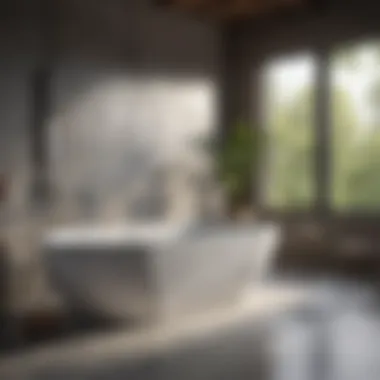
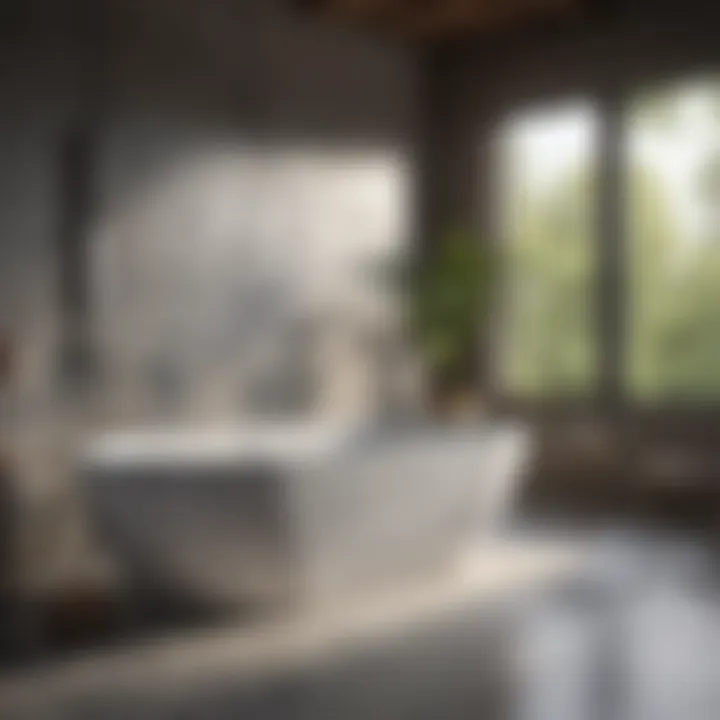
Not only do these fixtures provide mere comfort, but they also boost efficiency. For example, automatic faucets equipped with sensors minimize water wastage and can often adjust water flow depending on how long you are washing your hands. Another standout innovation is the self-cleaning toilet, which uses UV light or other mechanisms to maintain cleanliness. People often overlook plumbing, but these updated fixtures show how technology can take the hassle out of household chores.
"Smart fixtures in bathrooms are not just about novelty; they're about blending convenience with functionality."
Integrating IoT for Enhanced Experiences
The Internet of Things (IoT) is a game changer for home design, especially in bath spaces. Integrating IoT devices creates an interconnected environment where different components communicate with one another. This means that your bathroom can deliver personalized experiences by adjusting lighting, temperature, and even music based on your mood or preferences.
Imagine having a routine where your smart mirror suggests the perfect lighting for your morning skincare regime, or your bath can fill up at the exact temperature you’ve programmed through your smartphone while you get ready for the day. Devices like the Philips Hue smart bulbs or the Nest Thermostat allow homeowners to orchestrate their space in ways that were once considered science fiction!
The main benefit of this integration is enhanced control and comfort. For housewives and homeowners, it makes daily tasks simpler and offers peace of mind, knowing that advanced technology watches over even the smallest aspects of life.
As consumers become more educated and the demand for smart homes grows, the future of bathrooms seems to be deeply tied to technological advancements. Embracing these trends can not only provide immediate benefits but also increase the value of your home in the long run.
Sustainability in Bathroom Design
Sustainability in bathroom design is no longer just a buzzword; it has become a vital consideration for the modern homeowner. As we navigate through environmental challenges, the interior designs of our private sanctuaries have to keep pace. The bathroom, often overlooked in terms of ecological impact, holds a significant place in our homes. This section sheds light on various aspects such as eco-friendly materials, efficient water use, and energy-saving solutions, showcasing their importance in fostering a healthier planet while accommodating stylish and functional living.
Eco-Friendly Materials for Bath Spaces
When it comes to creating sustainable bathrooms, the materials you choose play a critical role. Shifting away from conventional materials that may leach harmful chemicals, there’s a growing trend towards eco-friendly options. Bamboo, for instance, is a renewable resource that's durable and aesthetically pleasing. Using cork flooring, known for its limited environmental footprint, can provide warmth and sound insulation.
Also, consider recycled glass for countertops, which not only gives a chic look but reduces waste significantly. Even ceramic tile can be an eco-friendly choice when sourced from manufacturers that value sustainable practices. Opting for naturally sourced stone or reclaimed wood adds a unique touch while ensuring that your space remains low-impact.
Remember, every small step counts when it comes to making eco-conscious decisions. Each choice reflects a commitment to sustainability that resonates throughout the design and functionality of the space.
Water Conservation Techniques for Modern Homes
Water conservation in bathroom design is critical for reducing utility bills and conserving this precious resource. In today’s environmentally-aware era, there exist numerous strategies homeowners can adopt to minimize water usage without compromising comfort.
For starters, installing low-flow showerheads and faucets can dramatically cut water consumption. Traditional showers use as much as five gallons per minute, whereas low-flow models can cut that number down to around two. Additionally, dual-flush toilets allow users to select the appropriate flush for liquid or solid waste, effectively reducing water waste by using less for light flushes.
Other techniques include:
- Collecting rainwater for toilet flushes and outdoor uses
- Implementing greywater recycling systems, which reuse water from sinks, showers, and laundry
- Using automatic shut-off valves which activate when hands are away, especially in hand-washing scenarios.
"Incorporating eco-friendly practices can lead to significant water savings over time, fostering both a green ethos and a sense of tranquility in your home."
In summary, sustainability in bathroom design isn't merely a trend—it’s a necessary evolution. By opting for eco-friendly materials and adopting effective water conservation techniques, homeowners can contribute to the collective effort of preserving our environment, all while enjoying contemporary and stylish living spaces.
Essential Products for Modern Baths
When it comes to designing a peaceful and functional bathing space, understanding the essential products for modern baths is key. These elements not only contribute to the aesthetic of the bathroom but also enhance the overall functionality and experience. A modern bath should serve as a personal sanctuary, orchestrating relaxation, comfort, and utility.
A thoughtfully selected array of products can transform a simple bathroom into a haven. Homeowners nowadays are leaning towards accessories that don’t just look pretty but also serve a purpose. It’s about blending style with efficiency. For instance, the use of smart faucets can save water, and heated towel racks can add to comfort during colder months. Investing in such products is not merely about indulgence but about recognizing the significance they hold in everyday life.
Must-Have Accessories for Enhanced Functionality
In today's fast-paced world, must-have accessories play a significant role in optimizing bathroom utility.
- Shower Caddies: These organize space effortlessly, keeping all bath essentials within an arm's reach. It’s frustrating to fumble around for shampoo when it’s just out of reach.
- Adjustable Showerheads: Not only do they add flexibility with customizable water pressure, but they also offer a spa-like experience. Using features like rainfall settings can make a routine shower feel luxurious.
- Non-Slip Bath Mats and Rugs: Safety should never take a back seat. A good quality rug not only keeps you from slipping on wet floors but also adds warmth and color to the bathroom.
Furthermore, consider integrating smart mirrors. Mirrors that adjust lighting based on the time of day can elevate your morning routine, creating an ambiance that feels tailored just for you.
Trendy Bath Linens that Elevate Comfort
Let’s talk about the unsung heroes of comfort: trendy bath linens. The role they play in elevating the bathing experience cannot be overlooked.
- Supreme Quality Towels: Opt for plush towels made from materials like Egyptian cotton. They are soft, absorbent, and have a touch that feels like a gentle kiss on the skin after a bath.
- Decorator Shower Curtains: A stylish shower curtain can serve as a breathtaking backdrop. Don’t shy away from bold patterns or vibrant colors; these curtains have the power to transform the entire atmosphere of the space.
- Luxe Bath Robes: A high-quality robe can turn the experience of stepping out of the tub into a moment of pure indulgence. Look for options with a soft texture and warming properties.
"The right linens go beyond functionality; they enhance the overall experience, turning a simple bath into a moment of relaxation."
It’s crucial to choose linens that not only look good but feel good too. Today’s trends encourage layering textures and mixing colors that speak to your personal aesthetic. They become an extension of your personality, harmonizing with the design language of the rest of the home.
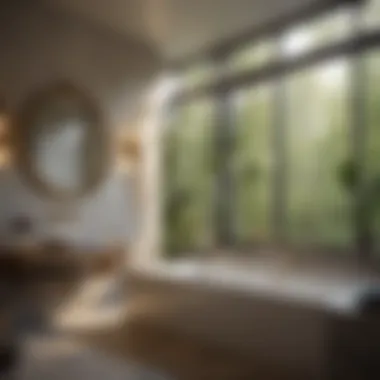
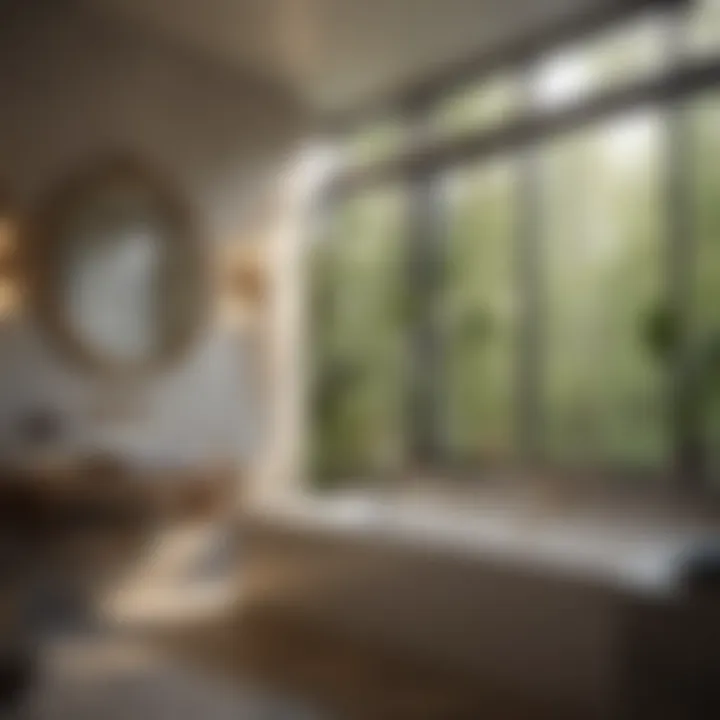
Creating a Cohesive Design: The Bath and Bedroom Connection
Creating a seamless connection between the bath and bedroom is more than just a design choice; it's a foundational approach to establishing a harmonious living space. As homeowners increasingly seek tranquility in their everyday lives, the intersection between these intimate spaces becomes crucial. A well-thought-out design ensures that both areas complement each other, fostering a sense of fluidity and comfort. By prioritizing a cohesive aesthetic, individuals enhance their overall dwelling experience, creating an environment that feels both functional and welcoming.
Harmonizing Decor Across Personal Spaces
When it comes to harmonizing decor in the bath and bedroom, one must consider various elements that reflect personal style while ensuring continuity. Here are certain key aspects to think about:
- Color Schemes: Using a shared color palette can unite both spaces. Soft, muted tones can evoke serenity, whereas bold hues may introduce a striking sense of modernity.
- Design Themes: Whether you gravitate towards a rustic charm or a sleek contemporary vibe, ensuring that both rooms resonate with the same theme can unify the experience.
- Decorative Accents: Items like mirrors, vases, or artwork placed in both spaces can serve as visual bridges. These accents can draw the eye from one room to the other, creating an instinctive flow.
- Functionality: Consider how functionality plays into design. For instance, a bathroom that incorporates decorative storage solutions can echo the organization found in a bedroom.
By carefully evaluating these elements, homeowners can effectively create a nurturing environment that encapsulates their personal style.
Color and Texture Continuity Between Bath and Bedroom
Sustaining color and texture continuity between the bath and bedroom is essential for crafting a well-integrated aesthetic. Think of it as setting the stage for a visual narrative that guides the senses through personal spaces. Here are a few tips:
- Shared Textures: Incorporating similar materials can unify design elements. For instance, a brushed-nickel faucet in the bathroom can align beautifully with a brushed-nickel light fixture in the bedroom.
- Consistent Patterns: If you choose certain patterns, such as floral prints or geometric designs, consider using them in both rooms, perhaps through textiles or wallpaper to create a cohesive story.
- Contrast Wisely: While some contrast can be refreshing, it should not feel jarring. Subtle variations, like a plush rug in the bedroom alongside smooth stone tiles in the bathroom, can play nicely off one another.
- Emphasize Natural Light: A bathroom with natural light can make colors appear different compared to a dimmed bedroom. Choosing window treatments that allow light in while ensuring privacy can help harmonize this aspect across the two spaces.
In summary, by weaving together color and texture thoughtfully, the transition between the bathroom and bedroom can cause a sense of belonging, making each visit to either space feel like a seamless experience.
"Design is not just what it looks like and feels like. Design is how it works." – Steve Jobs
This article segment underscores the essence of coordinated design through practical strategies, assuring every householder can create an inviting, cohesive atmosphere in their sanctuary.
Global Influences on Bath Trends
Examining global influences on bath trends is essential to understand how cultural context shapes modern bathing spaces. Bathing practices are deeply intertwined with tradition, regional customs, and even societal values. Acknowledging these influences can offer homeowners innovative ideas to create spaces that are not just pleasing to the eye, but resonate with meaning and purpose. The beauty of building a bathroom stance on global inspiration is that it merges aesthetics with functionality, prompting thoughtful engagement and reflection in the daily routine of bathing.
Cultural Approaches to Bathing
Across different cultures, the practice of bathing carries various meanings. In Japan, for example, the ritual of the onsen bath is more than just cleansing; it's a meditative experience steeped in relaxation and community. Users soak not just to wash away dirt, but to retreat into tranquility and reconnect with nature. This cultural nuance stands in stark contrast to the hurried, functional showers often typical in Western societies.
Moreover, the Turkish hammam focuses on social interactions, providing a communal space where people gather to converse and unwind. These activities showcase how bathing is an experience that goes beyond the physical—it's an avenue for social bonding and personal wellness.
By integrating elements from these rich traditions into local designs, homeowners can create bathrooms that invite connection and foster relaxation. Consider using warm, natural stones reminiscent of an onsen or designing spacious areas that facilitate social interaction, like a modern hammam.
Adapting Global Styles to Local Spaces
Adapting global styles to fit local contexts requires a balance of respect for tradition and creativity. Not every element of an international trend will work in every environment, but elements can be selected to align with existing home aesthetics and the unique needs of the homeowner. For instance:
- Mosaic Tiles: Inspired by Moroccan design, these colorful tiles can transform walls and floors, adding vibrancy.
- Scandinavian Minimalism: This style celebrates simplicity and functionality with an emphasis on natural light and airy spaces. Adopting this approach can help declutter and streamline bathrooms into serene getaways.
- Zen-like Simplicity: Inspired by Japanese aesthetics, incorporating bamboo and stone can create a calming environment conducive to meditation and reflection.
While blending these styles, one might consider the practicalities of space, climate, and available resources. For example, selecting materials that are sustainable in a regional setting—like bamboo in tropical climates or stone in more temperate zones—can enhance both beauty and functionality. It's about taking a thoughtful approach to design, making certain that the integration of global influences feels organic and enhances, rather than overwhelms, the personal space.
"When styles from around the world come together, they not only beautify the space, but also tell a story. It's a narrative of where we’ve come from and how we’ve evolved as inhabitants of our spaces."
Future Trends in Bath Design
The future of bath design is not just about transforming a mundane space into something visually appealing. It’s about reflecting evolving lifestyles, sustainability goals, and technological advancements. As we look ahead, a few pivotal trends emerge that will shape the bathing experience, making it more aligned with personal well-being and environmental responsibility. Understanding these trends is crucial for homeowners who aim to create not just a bathroom but a sanctuary of comfort and rejuvenation, tailored to contemporary needs.
Predicted Innovations in Bath Fixtures
Expect to see a surge in smart fixtures that revolutionize our daily routines. Brands are focusing on integrating technology into fixtures, leading to solutions that enhance both convenience and efficiency. For instance, motion-sensor faucets that minimize water wastage are gaining traction, marrying functionality with eco-friendliness. Likewise, programmable shower systems are allowing users to control water temperature and pressure using a single touch or voice command.
Bold predictions for upcoming innovations include:
- Self-Cleaning Toilets: Utilizing UV light technology, these toilets promise hygiene without the hassle of manual scrubbing.
- Smart Mirrors: These mirrors, embedded with LED lights and touchscreen controls, can display not just reflections but also information such as news, weather, or even a skincare routine guide.
- Adaptive Showerheads: These fixtures can adjust water flow based on user preferences and can even sync with IOT devices to provide personalized settings for each family member.
These innovations are not merely gadgets; they represent a significant shift towards a more interconnected and user-centric bathroom experience. As technology continues to advance, the fixtures we use will likely become intricate parts of a larger home ecosystem, ushering in a new era of smart living.
Anticipated Shifts in Consumer Preferences
Shifting consumer expectations are a reflection of broader societal changes. In recent years, there’s been a notable shift towards personalization in home design. Households are increasingly looking for solutions that cater to individual needs and sensibilities rather than one-size-fits-all options. Hence, it’s essential for bathroom designs to incorporate flexibility and encourage user interaction.
Key consumer trends to watch include:
- Sustainability Focus: More homeowners are considering eco-friendly options that utilize recycled materials and energy-efficient products. The rise of bamboo vanity units and low-flow fixtures speaks to this environmental consciousness.
- Wellness Integration: People are not just searching for aesthetic renovations. They seek spaces that support relaxation and mental well-being, leading to increased interest in features like steam showers and soaking tubs reminiscent of spa experiences.
- Customization Over Conventionality: Prefabricated units are losing favor as customization becomes an expectation. Consumers want unique touches, whether through bespoke cabinetry or artistic tiles that reflect personal taste.
"As we move forward, the bathroom becomes much more than a utility space; it transforms into a personal retreat, a place tailored to individual preferences and aspirations."
In summary, understanding these future trends is vital for homeowners striving to create an oasis that reflects their lifestyle and values. Whether it’s through innovative fixtures or thoughtful design choices, the evolving bath design landscape promises a leap toward more harmonious living.



